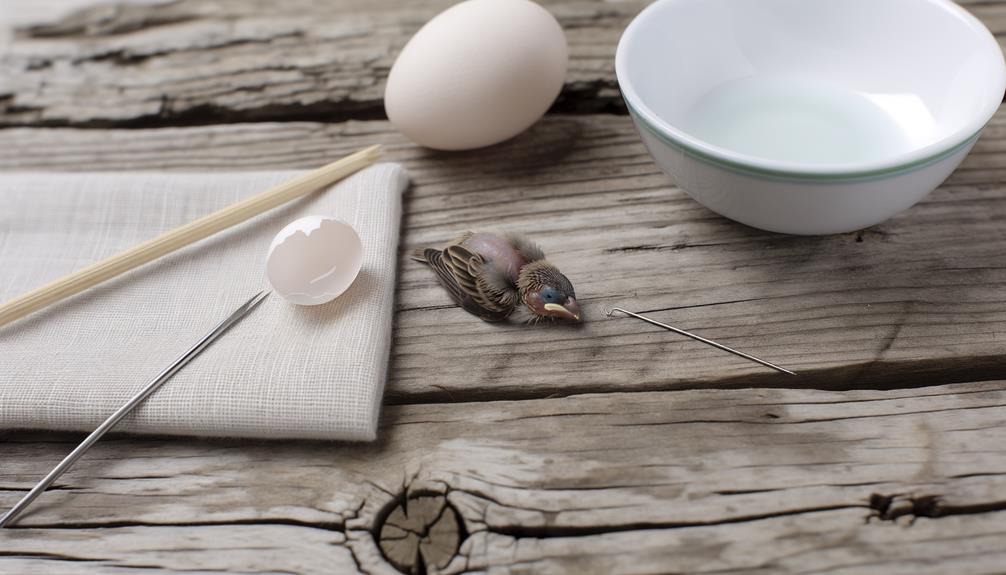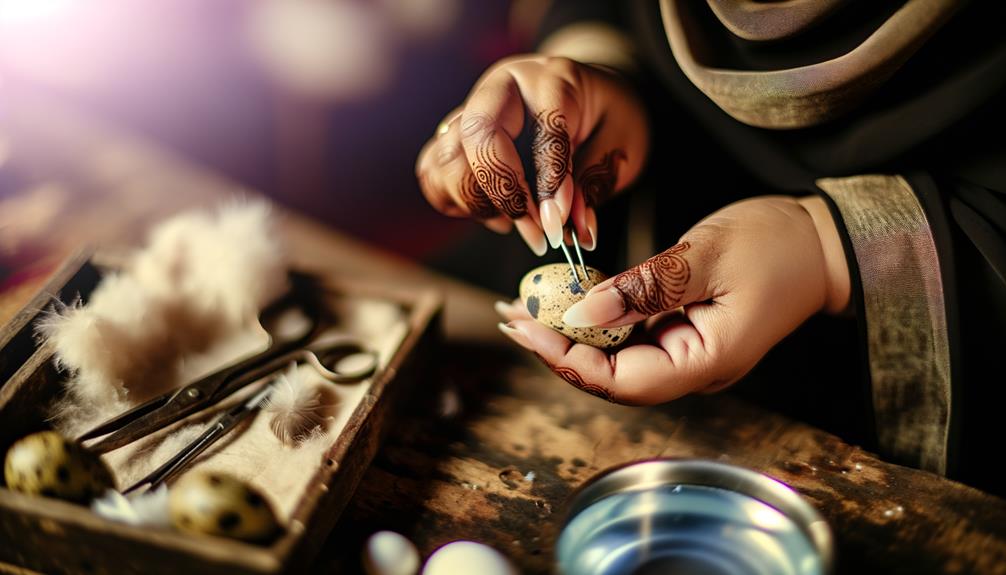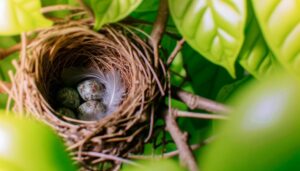7 Simple Steps to Blow Out a Sparrow Egg
To blow out a sparrow egg, start by gathering a small, sterilized needle, a syringe, and vessels for the egg's contents. Rinse the egg with lukewarm water, pat it dry, and sanitize it with a mild bleach solution.
Using the fine needle, create small holes at both the broader and narrower ends of the egg, ensuring the openings are clean and free of fragments. Hold the egg carefully and apply gentle pressure to expel the contents through the holes.
Rinse the empty shell, clean it with a soft brush, and sterilize it before letting it air dry for 24 hours. Continue for a more thorough understanding of this meticulous process.

Key Takeaways
- Rinse and pat dry the egg, then sanitize it in a mild bleach solution.
- Use a fine, sterilized needle to create 1-2 mm holes at both ends of the egg.
- Hold the egg securely and gently blow air through one hole to expel the contents.
- Rinse the emptied egg under lukewarm water and clean it with a soft brush.
- Allow the egg to air dry for 24 hours and sterilize it with diluted bleach to prevent mold.
Gather Your Supplies

To commence the process of blowing out a sparrow egg, it is vital to gather the necessary supplies, which include:
- A small, sterilized needle: This guarantees that no contaminants are introduced, preserving the integrity of both the egg and its contents.
- A receptacle: Necessary to collect any expelled material, avoiding unnecessary mess.
- A syringe: A crucial instrument for precisely controlling the air pressure applied, safeguarding the egg's delicate shell from damage.
- A vessel for the egg contents: Required to store the egg contents, which may be utilized for scientific analysis.
Assembling these tools prior to initiation ensures a streamlined and efficient process, reducing the likelihood of errors.
Prepare the Egg
Maintaining the egg's cleanliness and free of debris is crucial for preserving its structural integrity during the blowing process. Begin by gently washing the egg under lukewarm water to eliminate any surface contaminants. Pat it dry with a soft cloth, avoiding any harsh materials that could harm the fragile shell. To further disinfect the egg, immerse it in a mild bleach solution (1-part bleach to 10-parts water) for approximately 2-3 minutes. Afterward, rinse thoroughly with clean water.
| Step | Description | Duration |
|---|---|---|
| Rinse | Use lukewarm water to cleanse the egg | 1-2 minutes |
| Dry | Pat dry with a soft cloth | 1-2 minutes |
| Sanitize | Submerge in mild bleach solution | 2-3 minutes |
This meticulous preparation guarantees the egg is prepared for the next steps.
Create Small Holes
Initiating the process of creating small holes in the eggshell demands a precise and steady hand to maintain the integrity of the shell while allowing the contents to be extracted. Using a fine, sterile needle or pin, carefully puncture a small hole at the broader end of the egg. This end typically contains an air sac, reducing the risk of damaging the yolk.
Rotate the needle gently to widen the hole to approximately 1-2 millimeters in diameter. A similar hole should be made at the narrower end for airflow. The technique requires slow, deliberate movements to avoid cracking. Observing the shell's resilience, adjust pressure accordingly.
Confirm both holes are clean and free from shell fragments to facilitate the subsequent steps effectively.
Blow Out the Contents
Blowing out the contents of the sparrow egg requires a methodical approach to guarantee complete removal while preserving the shell's structure.
First, hold the egg securely, making sure the previously created holes are unobstructed.
Position your mouth over the larger hole, applying steady, gentle pressure to expel the contents without cracking the shell. The yolk and albumen should flow out through the smaller hole. If resistance is encountered, adjust the angle or increase pressure slightly.
Periodically check the egg for remaining contents by shaking it gently; any residual material should be expelled with continued blowing.
This meticulous process ensures the shell remains intact, ready for subsequent steps in the preservation process.
Clean and Preserve

To thoroughly clean and preserve the sparrow egg shell, one must first rinse the empty shell under a gentle stream of lukewarm water to remove any remaining residue. A soft, fine-bristled brush can aid in delicately cleaning the exterior surface. After rinsing, allow the shell to air dry completely.
- Sterilize: Submerge the shell in a solution of diluted bleach (1 part bleach to 10 parts water) for 2-3 minutes to eliminate bacteria.
- Rinse Again: Confirm all bleach is thoroughly rinsed off with lukewarm water.
- Drying: Place the shell in a well-ventilated area to air dry for 24 hours to prevent mold.
These steps secure the shell remains intact and free from contaminants, preserving its natural beauty.
Conclusion
The intricate dance of extracting the delicate contents of a sparrow egg mirrors the precision of a surgeon's hand. Each step, from gathering materials to creating tiny openings, demands meticulous attention.
The final act of blowing out the egg's essence, followed by careful cleaning and preservation, transforms the fragile shell into a silent testimonial of nature's artistry. This method, performed with scientific rigor, guarantees the preservation of the egg's ethereal beauty and structural integrity for future examination.






